Conventional fabric dyes are bad news. The runoff from fabric dye pollutes waterways, and the dyes themselves are not so healthy for workers who are around them day in and day out, either. Luckily, you don’t need harsh, chemical dyes to tint fabric in lovely colors! You can use natural, food-based ingredients like fruits, veggies, and herbs to create your own non-toxic fabric dye.
If you’ve every cooked with turmeric, you know that it stains fabric like gangbusters. Heck, it even stains your hands, if you handle it too much. The property that calls for caution in the kitchen is your ally if you’re looking to dye fabric a cheery shade of yellow! Here’s how to make a batch of fabric dye from turmeric, water, and just one other ingredient that’s most likely already in your kitchen!
Materials
- 4 cups of water + 1/4 cup table salt
- undyed or light colored fabric of your choice. I used a vintage hankie that I picked up at Salvage:
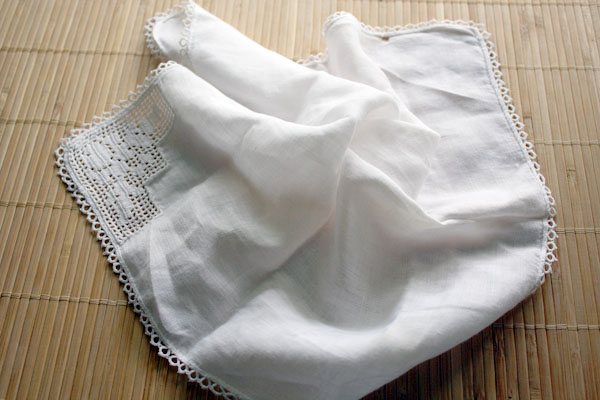
- 2 cups water + 2 tablespoons of ground turmeric
- non-reactive sauce pan (stainless steel or ceramic will work best)
- wooden spoon
Directions
1. Combine the water and salt in your pan and bring it to a boil, then add your fabric and let it simmer for one hour. The salt is your “fixative,” which helps your fabric take the dye.
2. Drain your fabric, wring it out when it’s cool enough to handle, and rinse your pot.
3. Combine the water and turmeric in the same pot, bring to a boil, and simmer for 15 minutes.
4. Turn off the heat, add your fabric to the pot, and use your wooden spoon to make sure that the fabric gets a nice coating in the dye. Let your fabric soak. The longer it soaks, the more vibrant your color will be check it after the first 5-10 minutes, then just keep checking on the fabric every few minutes until you get the vibrancy you’re looking for. Make sure that each time you pull the fabric out of the dye that you use your wooden spoon to fully submerge it again – you don’t want the dye job to turn out uneven! I let mine soak for about 15 minutes, and you can see the result in the photo at the top of this page.
5. Rinse your fabric in the sink until the water runs clear, hang it to dry, and you’re ready to craft with your turmeric dyed fabric!
This made more than enough dye for my little handkerchief, so I poured the leftover dye into a glass jar and am storing it into the fridge for another project. I’m not sure how long it will keep, but a week or two sounds reasonable. Refrigerator pickles keep for about that long, and this is just turmeric and water. If anyone knows the shelf life for natural fabric dyes, I’d love to know!



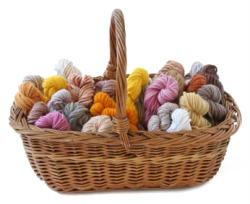



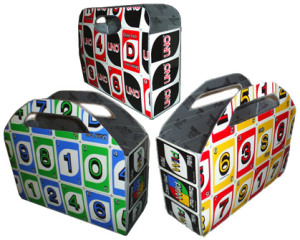
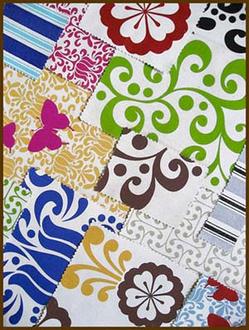
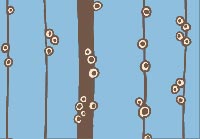
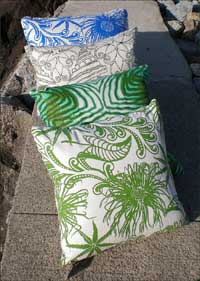
Pingback: How to Make Natural Fabric Dye | Glue and Glitter
I love this idea! I’ve been wanting to get into natural dyes, and this seems like a great place to start. Bright and cheery!
Pingback: How to Dye Fabric with Turmeric | Glue and Glitter
Do you know if it would work on hair?
I haven’t tried it, but if you give it a go, I’d love to hear how it works out.
How would you boil your hair in salt water for an hour?
I guess you’d have to find a different mordant.
So cool! Such a pretty cheery yellow! I have read on all the natural things you can use to dye fabric. I am saving red onion skins hoping to use them someday. I should save my used coffee grinds and see what happens with that. Hope you have a series going. I’d love to see your future experiments!
So far, I’ve only experimented with turmeric and with red cabbage (http://www.glueandglitter.com/main/2012/05/07/red-cabbage-fabric-dye/). Leslie shared a tute back in 2008 on how to use plum skins. The color on that one looks great! Here’s a link to the plum skins dye:
http://craftingagreenworld.com/2008/07/11/diy-make-natural-non-toxic-dye/
I’d love to hear how the red onion skins turns out. I bet that makes a nice purple or pink!
Pingback: Link Party #14: EV’s, Guaranteed Income, and Volcanoes, oh my! | Important Media Insights
Pingback: Explore Important Media’s Weekly Link Party
Hello! I’m using raspberries and blueberries right now — trying to dye a newborn onesie. I set the material with water and sea salt, but I’m still wondering if anyone has had success with washing their dyed clothes? Will my onesie’s colors bleed in the washing machine?
Thank you for your help! 🙂 And for this fun recipe!
what can I use to create a green coloured dye?
I have a few suggestions for making different colored dyes over on my personal site:
http://www.glueandglitter.com/main/2012/05/09/how-to-make-natural-fabric-dye/
Hi, this is great news! Love it! Was wondering if anybody could kinda give me the length of time this will last after washing? Seems like it would wash out in 1 or 2 washes. How long has your own dye lasted you?
It actually does last, though the color will fade with the first washing. You can check out before and after photos of the washed fabric here:
http://www.glueandglitter.com/main/2012/07/13/can-i-wash-food-dyed-fabric/
That page no longer exists. I would have liked to see how much fading there is after the first wash
hi, may i know what can i use to make an off-white/champange colour dye? i need to dye a lace top which is too white to suit my gown.
Tea might work for that. I’d test it on a scrap of fabric before dyeing the top, though, just to be sure.
Henna works for a nice champagne color, just make sure you don’t leave it in the dye for more than 7-10 minutes
So, was trying to do too many things today, and didn’t completely follow directions as I should have. I let my turmeric cook for probably close to three hours, without the fabric at first, then with the fabric in it, then, left it still on for another hour on accident, then threw something else in there (i also had boiled about 1/2 a cup of water with two avocado skins and put that in with the original water because I was going for a more mustard yellow) but man! I ended up with a really cool color somewhere between yellow and burnt orange! Now I am afraid to put it down the drain, because I want to be able to use it again! Just wanted to share in case someone is going for that color!
That sounds awesome! Do you have a photo you can share?
My kids and I have just begun and dandelion flowrrs were first it produced a light yellow as one would expect. I am just experimenting right now so i used the same shirt in the turmeric, a beautiful mustard orange. i then tied my sons sleep shirt into a bunched ball and dropped it in I let it go for about ten mins when i pulled it out I rinsed and dropped my dove handsoap bar on it. Amazingly it turned it purple. It now has a hippie tie dye look. lol the kids love it hopefully it stays that way
Pingback: c. 1787 chemise: natural dyes | la couteriere
I had experimented with this yellow tumeric dye on a couple onesies over christmas. After rinsing til it ran clear it dried to a beautiful strong yellow. So today I went for it again. Honestly, i just winged it. I started to boil water, threw in some tumeric (forgot all about adding salt to fix) and the onesie and once it boiled, turned it down to simmer, set the timer for an hour an came back 2 hrs later? (what’s on te stove? Oh crap!). Anyways, i was afraid I had burned the fibers with how hot it was, but they looked fine when I began rinsing and rinsing. When it finally ran clear, I wanted to remove the tumeric smell (since it was a gift) and added some detergent. It’s not a regular detergent (called “ROMA” and my mom swears by it) and it’s made in Mexico. Anyways, as soon as I added the powdered soap, ton’s of orangy-yellow dye came out and it turned a darker orangy color! I kept rinsing til it ran clear. Then, just to make sure, added another soap rinse. Again, TONS! of color coming out and now the onesie isnt yellow anymore, its kind of dark orangy-red! After several (8-10) of these soap-rinses (everytime releasing a lot of yellow dye), the color is burnt orange, not so dark anymore, but certainly not yellow at all! lol FYI folks, give your completed natural dye project a little mexican soap rinse to make sure it wont leak tons of yellow color in the wash OR that it doesnt change color. I wish I knew what was causing this color change reaction, I felt like a scientist. LOL
How cool! Yay for SCIENCE!
Thats really cool! I have a linen tank top that I really want to dye a burnt orange
I tried this method for dyeing a cotton shirt. It worked quite well. I may have made the turmeric bath a little too concentrated because the colour was more orange than I was going for. I rinsed it out after and hand washed it with some liquid detergent. This seemed to make it more orange-y. So I splashed some white vinegar into a bowl of water and dunked the shirt in there. The colour instantly lightened to a truer bright yellow. I think the vinegar also stopped the colour from bleeding because my rinse water was totally clear. So vinegar may be a good way to fix the dye more permanently.
I wonder if heat setting would help the colors not fade as quickly? Throwing something in the dryer, even on extra low, to dry instead of hanging it might help. Of course, the trade off is shrinkage.
First, dyeing cellulose vrs protien fibers is a completely different gig. Cellulose fibers require soda ash and other mordants and depending on your immersion technique, different rates of temp. Turmeric is strong, so chances are you will have permanently “stained” your shirts…but if you have not mordanted then, the vibrancy will not last. Worse, if you did not properly rinse until the water runs clear you will run the risk of the shirt or cloth damaging everything it comes into contact with when it gets wet. You have to wash it several times at proper temp in your washermachine, at least until the water runs pure.
Protein fibers are easier to mordant- for natural mordants you will need any type of alum, tin, copper or iron and a high (proper) rate of temp…however they too need to be rinsed properly. They also need to be scoured before and after going into your dye pot for max receptivity.
Salt isn’t a mordant, it’s a receptor. It helps keep water molecules attach during a vat dyeing process. It’s worthless for other types of immersion or dye painting techniques.
Basically you are trying to burn/set molecules and reattatch them to the right ions and make sure they never un-attatch. But the method your using is very unstable and I would never bring those pieces of fabric out in the rain, or spill cold water on them…or worse, wash them in the same cycle with other clothes….
Thank you so much for all of this good information! All that I know about dyeing fabric is from trial and error, and it’s great to read some of the science behind turning fabric pretty colors.
I have always been told to use vinegar (white or brown) to set dyes. My mother advised this. Since I am an old girl this is one of those old home type solutions. But think how you set dyes on an Easter egg, you add vinegar, kind of makes sense.
I don’t know if this will affect the color of the dye, I imagine it depends on the phone of what you are using
OOPS!!! That should have been PH not phone– stupid autocorrect
I received a cosplay outfit that was supposed to be green with yellow accents. It arrived as blue with yellow accents. (Thanks China. :/ ) Will this turmeric approach turn it green and brighten the yellow accents?
Hi Steve,
Sorry about the outfit. As far as turning an outfit a different color, It really depends on what the fabric is. Natural fibers; cotton, silk, linen, wool (lanolin can prevent absorption)—in that order—are the best in my experience. Most synthetics are designed to be “stain-proof” aka “dye-proof”. A quick web search reveals that there are chemical dyes marketed for polyester, but from what I saw ya need twice the dye and very high heat. Tis possible that the same would work for natural dyes (wouldn’t count on it though).
BTW, I have never dyed anything via the “washing machine” method. Just seems counter-intuitive to throw dye into a machine meant for washing your clothes.
Happy crafting everyone,
Sam H.
I have used Dylon commercial dye in the washing machine three or four times – all with excellent results. (I dyed the Ghost trousers I wore to get married in dark blue. Ghost clothes are great for dyeing – no synthetic thread used to sew the viscose fabric (which is made of wood pulp). I told my friends I got married in clothes made of wood and they thought I’d made a spelling mistake and meant wool!
I use tumeric as a washing powder – for alergies and a better smell. The colour is incidental, but the yellow is not troublesome as long as you rince well in hot water. I don’t boil the stuff at all, but the yellow accumulates quietly and evenly.
Used tumeric to dye some onesies. The color was a deep golden yellow when I took it out of the dye bath and rinsed it out. When I washed it with homemade washing powder (baking soda & washing soda) it turned a gorgeous red/pink. Very strange! Once rinsed again and dried, I was left with a pastel yellow. Quite nice and perfect to cover the stains on the onesie made by my breastfed baby.
Just experimented today for 1st time I placed 100 g of brown onion outer flake into about 3 litres of water brought to a boil for 30 mins and left overnight. Strained off cold dye water and reheated it next day to dye a white shirt (dry fabric weight 190g). Let it sit in boiling dye water for 30 mins and let it cool off overnight… got the most beautiful light tan colour. Haven’t used a mordant but if colour runs I intend to add 2tbspns alum to water, heat to a boil, turn off heat, then soak it overnight again
Here’s goes nothing…. My daughter is desperate to be Pikachu for Halloween this year and the only yellow clothes we can find in stores are neon. I have no desire to buy her a $30 dress on Amazon that she will wear once. So, we found a white shirt and skirt, both 100% cotton, that she already has but doesn’t wear much anymore. Let the dyeing begin!
You can do it! The dye will fade when you wash, but you still end up with a nice, sunny yellow.
I’m about to try this with some socks. My daughter wants to be Hulk Hogan for Halloween :-)). Not sure about the fabric they’re made of so fingers crossed.
Pingback: Alternative Gift Wrapping – A Waste Not Kind Of Life
This is a great idea. I stained a beautiful white blouse when I was cooking with turmeric (completely not thinking about the ingredients!) and as much as I tried to remove the stains, they are definitely there to stay. I’ll try dying the whole blouse now to give it new life!
If you need more dye for larger item do you just double the measurements??
Excellent I’m all for using natural products as a dye. I have been using tea, and certain vegetables: onions, red cabbage, and beets, with great success!
The storage in the fridge will last!!
I recently made a Take Away bag from Calico but decided it was too white for the job. I was delighted to find your tutorial and excited with the results in my fabric dyeing. I look forward to experimenting more in the future! Blogged about here:
https://theflashingscissors.blogspot.com/2019/08/my-eco-take-away-bag-turmeric-dyeing.html
Thank you again for your very helpful tutorial!
Barbara
If you mix baking powder to the mix it turns it bright red! Maybe something you could do with the left overs!
This is great! I am thinking about dying my bed sheets with turmeric. I am worried about it staining my skin while I sleep or the mattress topper. Do you think that this will be an issue or once it dries, it no longer stains?
Turmeric turns reddish orange at high (alkaline) pH. Most normal soaps (as in, standard non-fancy bar stuff, Mexican laundry soap, castile, etc) are made of fat and sodium hydroxide (lye), and end up quite alkaline. It’s the reason all the nice body washes say “pH balanced,” because by default soap is way more alkaline than human skin is supposed to be.
The dye molecules from turmeric are more soluble in alkaline liquids than neutral or acidic liquids, so washing with an alkaline laundry soap are really likely to pull the dye out and turn it reddish. I’m experimenting with vinegar rinses (traditionally in India and nearby they used citrus juice) to try to keep the yellow color popping.
Turmeric is not very light/wash fast but it’s real easy to re-dye! (That’s what was commonly done in India before synthetic dyes: just repaint your turmeric yellows.)
Pingback: DIY Natural Clothing Dye - The Useless Project